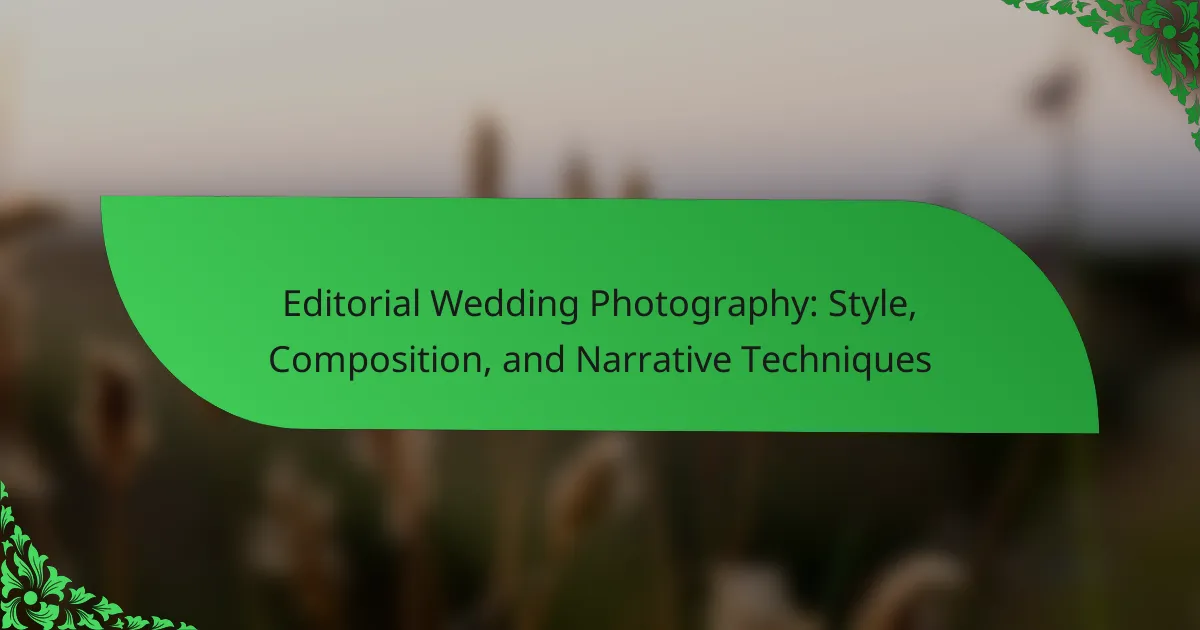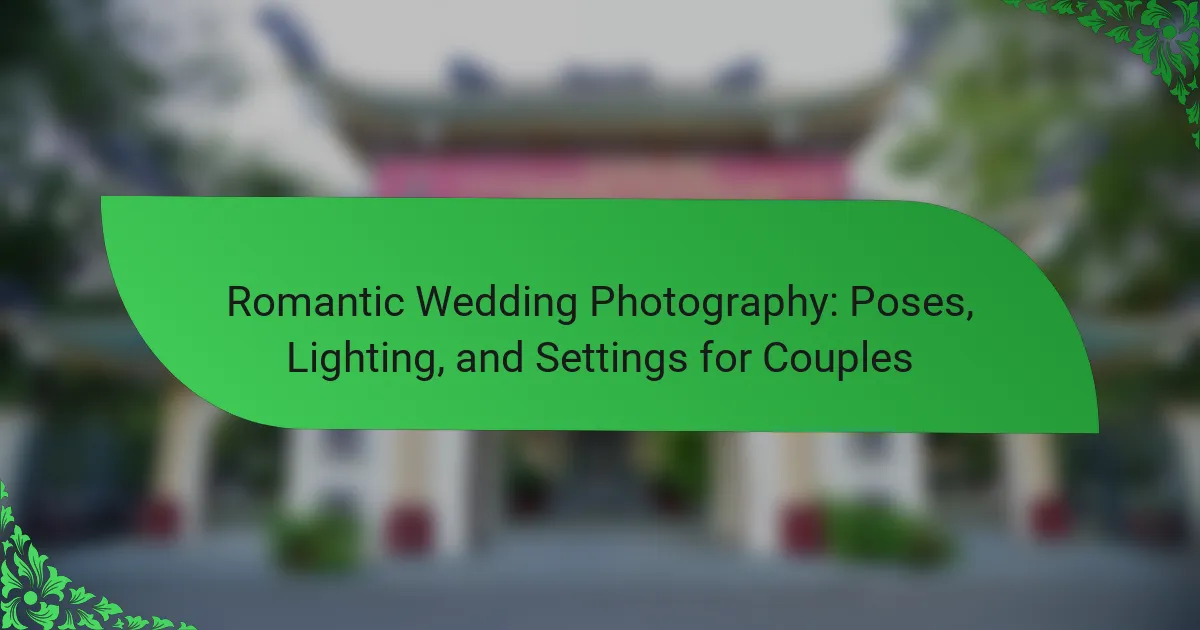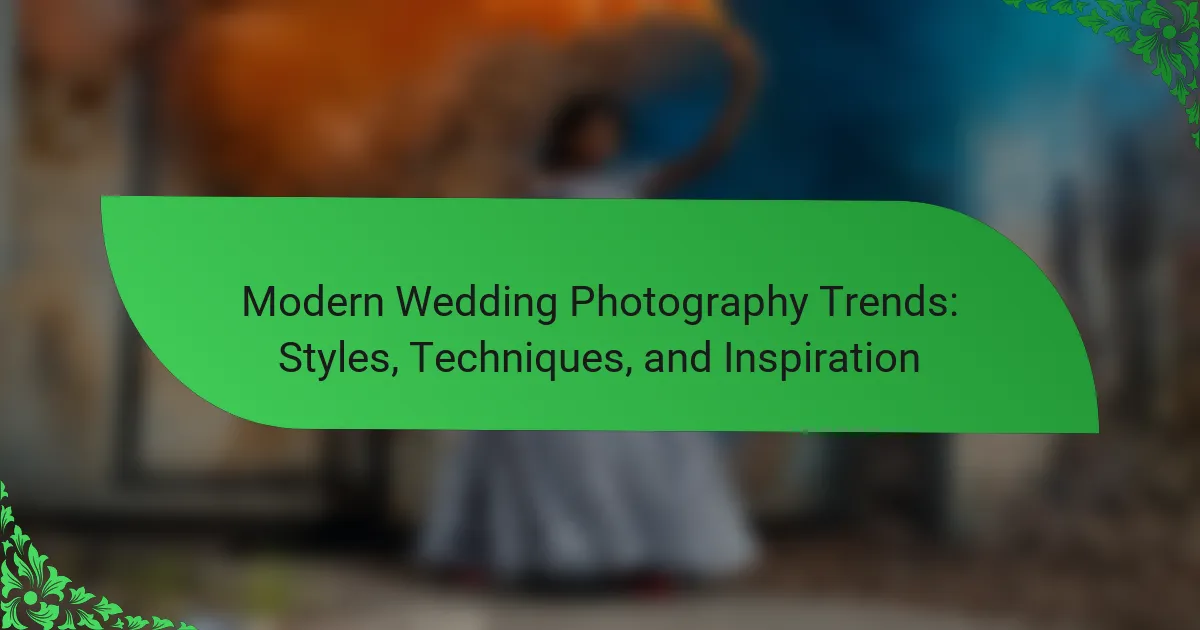Minimalist wedding photography emphasizes simplicity, clean lines, and essential elements to create timeless visuals. This style prioritizes uncluttered backgrounds, limited color palettes, and the use of natural light, allowing genuine emotions and the couple’s connection to take center stage. Key components include effective composition, the use of negative space, and a focus on capturing authentic moments. By highlighting elegance and clarity, minimalist wedding photography tells a compelling story through its straightforward approach.

What is Minimalist Wedding Photography?
Minimalist wedding photography focuses on simplicity and clean lines. It emphasizes essential elements without distractions. This style often features uncluttered backgrounds and limited color palettes. Photographers capture genuine emotions and moments in a straightforward manner. The goal is to tell a story with minimalistic visuals. This approach highlights the couple and their connection. It often utilizes natural light to enhance the simplicity. Minimalist wedding photography is increasingly popular for its timeless appeal.
How does Minimalist Wedding Photography differ from traditional styles?
Minimalist wedding photography emphasizes simplicity and clean lines, contrasting with traditional styles that often include elaborate setups. Minimalist photographers focus on the essence of the moment rather than ornate details. They utilize negative space to create a sense of openness. Traditional photography tends to capture a broader range of elements, including decorations and large group shots. In minimalist photography, fewer subjects are often featured, highlighting emotions and connections. This style aims for a timeless aesthetic, while traditional approaches may lean towards more conventional and posed compositions. Minimalist photography often employs natural light, enhancing the purity of the images, unlike traditional methods that may rely on artificial lighting.
What are the defining characteristics of Minimalist Wedding Photography?
Minimalist wedding photography is characterized by simplicity, clean lines, and a focus on essential elements. This style often utilizes negative space to draw attention to the couple and their emotions. It emphasizes natural light and soft colors, creating a serene atmosphere. Minimalist compositions tend to avoid clutter and distractions, allowing the beauty of the moment to shine. The approach often includes candid shots that capture genuine interactions. Additionally, it may feature close-up details, highlighting significant objects like rings or floral arrangements. Overall, minimalist wedding photography aims to tell a story through a refined and understated lens.
Why is simplicity a key aspect of this photography style?
Simplicity is a key aspect of minimalist wedding photography because it emphasizes clean lines and uncluttered compositions. This style allows the subject to stand out without distractions. By focusing on essential elements, the photographer captures the emotion and essence of the moment. Simplicity enhances the overall aesthetic, creating timeless images. Research shows that minimalist designs evoke feelings of calm and clarity. The lack of complexity often leads to stronger emotional connections in the viewer. This approach aligns with the essence of weddings, which are moments of intimacy and joy.
What are the core approaches to Minimalist Wedding Photography?
Core approaches to Minimalist Wedding Photography include simplicity, focus on emotions, and natural light usage. Simplicity involves capturing essential moments without distractions. This approach emphasizes clean compositions and uncluttered backgrounds. Focus on emotions highlights genuine interactions between the couple and guests. Photographers aim to document heartfelt moments authentically. Natural light usage enhances the aesthetic quality of images. It creates soft, flattering tones and avoids harsh shadows. These approaches result in timeless and intimate wedding photographs.
How do photographers choose their subjects in a minimalist approach?
Photographers choose their subjects in a minimalist approach by focusing on simplicity and essential elements. They select subjects that convey emotion or meaning without distraction. This often includes single objects or individuals against a plain background. The goal is to highlight the subject’s form and presence. Photographers also consider lighting and composition to enhance the minimalist aesthetic. By using negative space, they draw attention to the subject. This technique creates a sense of calm and clarity in the image. The minimalist approach often results in striking and memorable photographs.
What techniques are commonly used to achieve minimalist compositions?
Common techniques used to achieve minimalist compositions include the use of negative space, limited color palettes, and simple geometric shapes. Negative space enhances the subject’s prominence by surrounding it with emptiness. Limited color palettes create a cohesive and uncluttered look. Simple geometric shapes streamline the visual elements, drawing attention to the core subject. These techniques are foundational in minimalist design and photography, enabling a focus on essential elements.
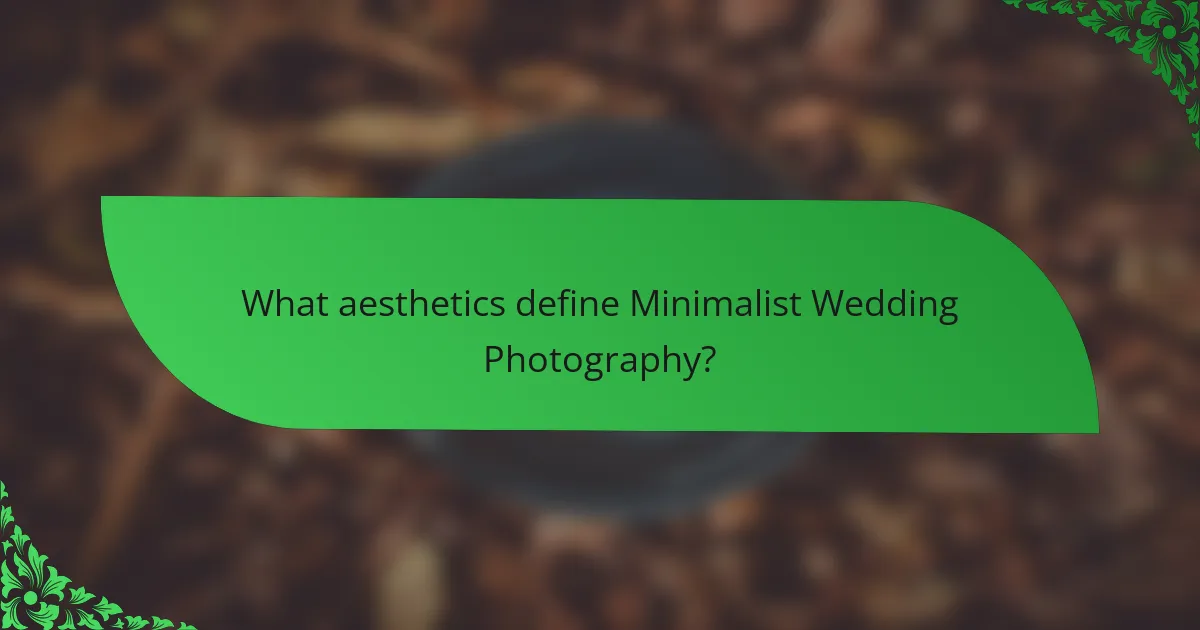
What aesthetics define Minimalist Wedding Photography?
Minimalist wedding photography is defined by simplicity, clean lines, and a focus on essential elements. This style emphasizes natural light and uncluttered compositions. It often features a limited color palette, typically using neutral tones. The use of negative space is prevalent, allowing subjects to stand out. Minimalist wedding photography captures genuine emotions without distractions. Each image tells a story through its simplicity. This approach often leads to timeless and elegant visuals. Photographers prioritize the couple’s connection, making it the focal point of their work.
How does color play a role in minimalist wedding photography?
Color is crucial in minimalist wedding photography as it enhances simplicity and emotional impact. Minimalist photography often utilizes a limited color palette to create a clean and focused composition. This approach draws attention to the subjects and their emotions without distractions. The use of neutral tones can evoke a sense of calm and elegance. Conversely, bold colors can convey energy and passion. Studies show that color can influence mood and perception, making it a powerful tool in visual storytelling. By carefully selecting colors, photographers can reinforce the wedding’s theme and atmosphere. Thus, color in minimalist wedding photography serves both aesthetic and emotional purposes.
What color palettes are most effective for minimalist photography?
Effective color palettes for minimalist photography include monochromatic schemes, neutral tones, and pastel colors. Monochromatic palettes utilize variations of a single color, creating harmony and simplicity. Neutral tones, such as whites, grays, and beiges, enhance the minimalist aesthetic by allowing subjects to stand out. Pastel colors add subtlety and softness, making images feel airy and light. These palettes help maintain focus on composition and subject matter. Research indicates that minimalist photography benefits from reduced visual clutter, making these color choices particularly effective.
How do lighting and shadows enhance minimalist aesthetics?
Lighting and shadows enhance minimalist aesthetics by creating depth and contrast. This interplay emphasizes simplicity in design. Natural light can highlight essential elements while casting soft shadows. These shadows add dimension, making flat surfaces appear more dynamic. High-contrast lighting can draw attention to specific features. It simplifies the visual narrative by reducing distractions. Studies show that effective use of lighting can evoke emotions and set the mood. Properly managed light and shadow can elevate the overall composition in minimalist photography.
What visual elements are essential in Minimalist Wedding Photography?
Essential visual elements in Minimalist Wedding Photography include negative space, simplicity, and clean lines. Negative space allows the subject to stand out, creating a strong focal point. Simplicity in composition eliminates distractions, emphasizing the couple and their emotions. Clean lines contribute to a modern aesthetic, enhancing visual clarity. Additionally, natural light plays a crucial role, providing soft illumination that complements the minimalist style. Limited color palettes further reinforce the aesthetic, often focusing on neutral tones. These elements together create a cohesive and elegant representation of the wedding day.
How does negative space contribute to the overall composition?
Negative space enhances overall composition by creating balance and focus. It refers to the empty areas surrounding the main subjects in a photograph. This space allows the viewer’s eye to rest and emphasizes the subjects. In minimalist wedding photography, negative space can evoke emotions and highlight intimacy. For instance, a couple framed by vast landscapes draws attention to their connection. Studies show that effective use of negative space can improve visual storytelling. By guiding the viewer’s gaze, it contributes to a more compelling narrative.
What role do textures and patterns play in minimalist images?
Textures and patterns in minimalist images enhance visual interest and depth. They provide subtle contrasts that draw the viewer’s attention. In minimalist wedding photography, textures can evoke emotions and set a mood. Patterns can create a sense of rhythm and harmony within the composition. For example, a smooth fabric against rough wood introduces tactile variety. This interplay enriches the narrative without overwhelming the simplicity. Studies show that well-placed textures and patterns can elevate the overall aesthetic appeal. They help convey the essence of the moment in a nuanced way.
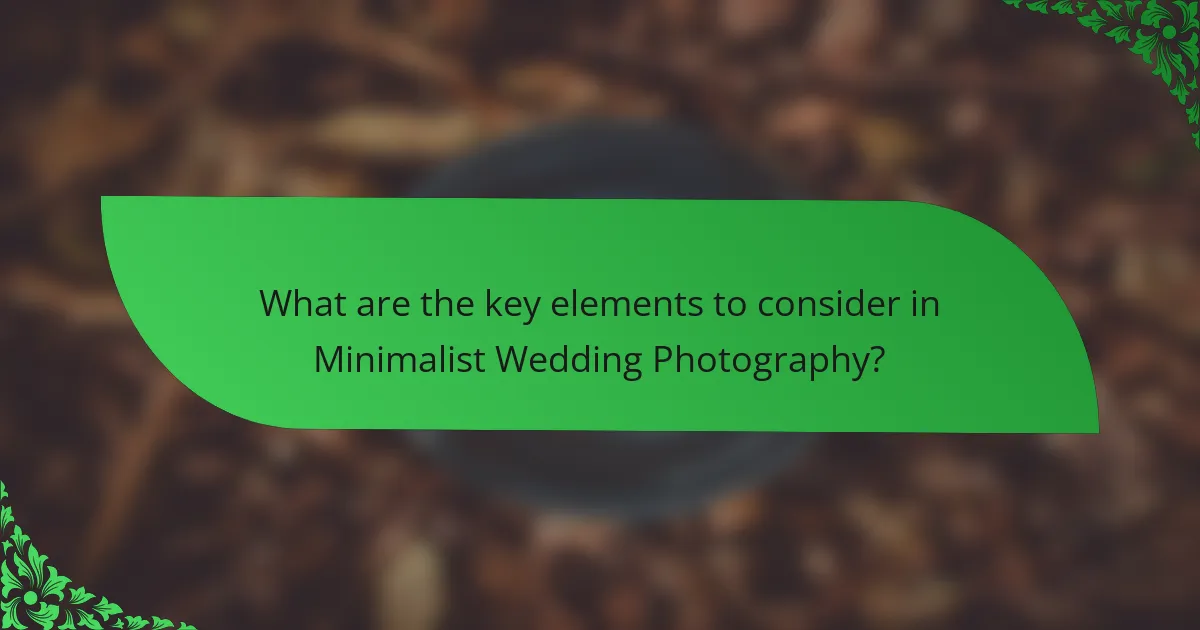
What are the key elements to consider in Minimalist Wedding Photography?
Key elements in minimalist wedding photography include simplicity, composition, lighting, and emotion. Simplicity focuses on uncluttered backgrounds and minimal props. Composition emphasizes framing and balance, often using negative space effectively. Lighting plays a crucial role in setting the mood and highlighting subjects. Emotion captures genuine moments, creating a narrative. Each element contributes to an overall aesthetic that prioritizes elegance and clarity.
How can couples prepare for a minimalist wedding photoshoot?
Couples can prepare for a minimalist wedding photoshoot by focusing on simplicity and intentionality. Selecting a clean and uncluttered venue is essential. Neutral color palettes enhance the minimalist aesthetic. Couples should choose outfits that are elegant yet simple, avoiding excessive embellishments. Props should be minimal and meaningful, contributing to the overall theme. Planning poses in advance helps maintain a cohesive look. Communication with the photographer about vision and style is crucial. Finally, practicing mindfulness during the shoot allows couples to embrace the moment fully. These steps ensure a successful minimalist wedding photoshoot.
What should couples communicate to their photographer about their vision?
Couples should communicate their specific style preferences to their photographer. This includes whether they prefer candid, posed, or a mix of both types of shots. They should also share their desired color palette and any specific themes or moods they envision. Additionally, couples should discuss important moments they want captured, such as the ceremony, reception, or special details. Sharing reference images can help convey their vision clearly. Couples should also inform the photographer about any must-have family or group shots. This ensures that the photographer understands their priorities and can plan accordingly. Clear communication helps align expectations and results in a more satisfying photography experience.
How can venue selection impact minimalist photography outcomes?
Venue selection significantly impacts minimalist photography outcomes by influencing composition, lighting, and subject focus. A venue with clean lines and simple backgrounds enhances the minimalist aesthetic. Natural light availability can create soft, flattering images that align with minimalist principles. Additionally, the scale and openness of a venue allow for better framing of subjects. Venues with cluttered environments can detract from the minimalist approach. Choosing a location that embodies simplicity helps to convey the intended message of minimalism. Research shows that environments with fewer distractions lead to more effective minimalist photography.
What are common challenges faced in Minimalist Wedding Photography?
Common challenges in minimalist wedding photography include limited backgrounds and distractions. Minimalist settings can restrict the photographer’s creative options. Capturing emotions in a simple environment can be more difficult. Fewer elements may lead to less dynamic compositions. The focus on simplicity can make it challenging to convey the wedding’s atmosphere. Lighting can be tricky, as minimal setups may lack natural sources. Additionally, clients may expect more traditional styles, leading to miscommunication. Adapting to clients’ expectations while maintaining a minimalist approach can be a significant challenge.
How can photographers overcome limitations of space and setting?
Photographers can overcome limitations of space and setting by utilizing creative angles and perspectives. They can also use wide-angle lenses to capture more of the environment. Lighting plays a crucial role; using natural light can enhance the scene. Additionally, incorporating minimal props can create focus without clutter. Photographers can scout locations in advance to identify the best spots. They may also consider post-processing techniques to enhance images taken in challenging settings. Experimenting with depth of field can isolate subjects effectively. Finally, planning the composition ahead of time ensures that photographers maximize the available space.
What strategies can be used to ensure emotional depth in minimalist photos?
To ensure emotional depth in minimalist photos, focus on strong composition and subject isolation. Use negative space to emphasize the subject’s emotional expression. Capture candid moments that convey genuine feelings. Utilize lighting to create mood and highlight emotions. Incorporate meaningful elements that tell a story. Choose a limited color palette to enhance the emotional tone. Experiment with angles to evoke different perspectives. These strategies help convey deeper emotional connections through simplicity.
What tips can help improve Minimalist Wedding Photography?
To improve minimalist wedding photography, focus on simplicity and essential elements. Use natural light to create soft, flattering images. Choose uncluttered backgrounds to emphasize the couple. Limit the number of props to avoid distractions. Capture candid moments that reflect genuine emotions. Pay attention to composition, utilizing negative space effectively. Experiment with angles to provide unique perspectives. Finally, ensure that the couple’s personalities shine through in the images. These strategies enhance the minimalist aesthetic and create impactful photographs.
How can photographers effectively use framing and composition techniques?
Photographers can effectively use framing and composition techniques by focusing on simplicity and balance. They should utilize natural elements to create frames within the scene. This technique directs the viewer’s attention to the subject. Photographers can apply the rule of thirds to enhance visual interest. Placing subjects off-center often results in more dynamic images. Leading lines can guide the viewer’s eye toward the focal point. Negative space can emphasize the main subject by reducing clutter. These methods have been proven to improve the overall impact of photographs, as supported by studies in visual perception.
What are best practices for post-processing minimalist wedding images?
Best practices for post-processing minimalist wedding images include maintaining simplicity and clarity. Focus on enhancing natural light and colors to preserve the minimalist aesthetic. Use subtle adjustments for exposure, contrast, and saturation to keep the images true to life. Crop images to eliminate distractions and emphasize the subjects. Employ selective editing to highlight key elements without overwhelming the composition. Limit the use of heavy filters or effects, as they can detract from the minimalist style. Consistency in editing across the collection ensures a cohesive look. Finally, always back up original files to maintain the integrity of the images.
Minimalist Wedding Photography is a style that emphasizes simplicity, clean lines, and essential elements, focusing on capturing genuine emotions and connections without distractions. This article outlines the defining characteristics of minimalist photography, including the use of negative space, natural light, and limited color palettes, while contrasting it with traditional wedding photography styles. Key approaches, techniques, and challenges are discussed, along with strategies for couples and photographers to enhance their minimalist wedding photoshoots, ensuring a timeless aesthetic that highlights the couple’s connection and intimacy.

